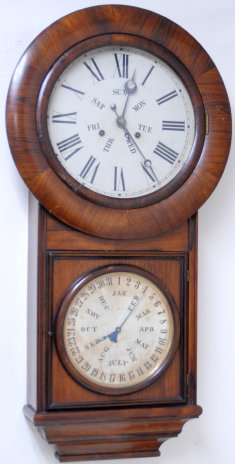

55. $1500
Waterbury Clock Company “Regulator No. 53”, ca 1906. This large
walnut case is 53 inches high, and has led a privileged life. Unlike most clocks this old it appears to have never been exposed to
smoke or other elements that penetrate the wood. Let’s say I could be wrong and someone long ago cleaned it to look original. At any
rate it is beautiful. Also, it is the only No. 53 I have noticed selling that was not made of oak. The consignor of this clock will
only part with it because of downsizing to smaller quarters. The glass is old, original, no way to be sure. The old dial pan has been
expertly repainted. Beyond that, everything else appears to be original and in excellent condition. It has a correct/original brass
bob, wood stick, signed porcelain beat scale, original hands, and compounded pulleys in the case top, iron movement mounting brackets,
and the two brass weighs. In the case is the small door key and the winding crank. The 8-day movement is time only with retaining
power, dead-beat escapement, and was recently serviced, so it is running and keeping time. In the base of the case is a perfect label.
We have sold very few No. 53’s, and the ones we have sold have sold have gone as high as $4000. We have seen sales on the east coast
for large amounts even with top or bottom decorative trim pieces missing. Ly-Waterbury #564. $1750-$2500.
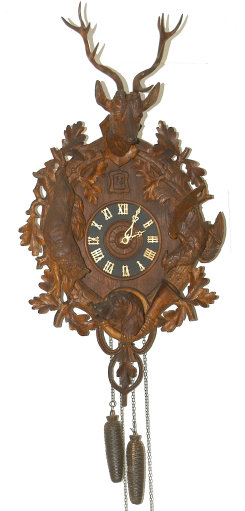
56. $1000
Large oval shaped cuckoo clock, ca 1865-1880. The age of the
clock was determined by examining the nice detail of the early carved wood bird sitting on a wood platform, the wire linkage, and
the exceptional carvings. Large deer head with carved wood antlers, carved dogs head and horn on the bottom, fox and bird on the sides.
All carvings are highly detailed and very intricately carved. Replaced backboard with an old gong. The movement has been cleaned and
is running great. The case is about 43 inches high including the antlers. There are some professional repairs to broken antlers and
a few other carvings. Overall the cuckoo is in excellent condition. You can enlarge the picture on the internet site to examine the
movement and bird more closely. This cuckoo was previously sold in the $2000 range. $1250-$1500.
54. $800
Waterbury Clock Co. banjo, “Willard No. 4”, ca 1906. The Willard
series of banjo’s are all weight driven and very large, 42” to 43” tall. This one has a large amount of the original paper label on
the back stating it is a Willard No. 4. The case is dark like most old mahogany cases but this one is made of Flemish Oak. It is all
original, has not been refinished or polished a whole lot in 100 years. The gold finial looks to be perfect. The gold around the original
painted glasses is also very nice and I believe it is original. Very little paint loss on the glasses and overall the paint is holding
nicely. The brass rails and bezel are clean and polished. The best thing about this banjo is the porcelain dial and it is signed.
The porcelain is perfect. Under the dial is a Waterbury 8-day movement that runs robustly. The brass bob is damascened, has been polished.
It has the original wood stick, original pendulum tie down, and original metal cover over the weight chute. The weight is original
or period and one would assume it came with the clock. Ly-Waterbury #124. $950-$1250.
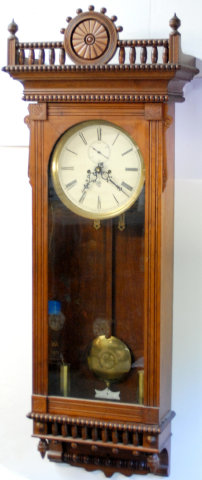

57. $550
“Waltham Watch & Clock Co.”, ca 1930 banjo clock. This clock
uses Waltham’s famous 8-day timepiece weight driven movement that is signed and numbered. The original internal parts are the movement,
pendulum, pendulum stick, weight chute metal cover, pendulum tie down bar, and the lead weight. The throat glass and the bottom Mt.
Vernon glass, were professionally restored by Tom Moberg. The dial pan is original but repainted by the Dial House. The signature
is good, hands are original, and the two door latches are in good working order. Mahogany case has the original finish, stands near
41” high, and retains the original mahogany finial and brass side rails. This style Waltham banjo clock regularly sells everywhere,
in the $2000-$3000 range. Well it used to and will again in a few years. Like the stock market, Buy Low, Sell High. Ly-American Clocks,
page 248. $600-$800.
53. $550
“Welch, Spring & Co., Bristol, Conn.”, No. 2 Calendar, ca 1878. There is a two-weight time only movement in the top part of this double dial calendar clock. In the bottom is a B. B. Lewis mechanism regulating the month and date. In the center of the upper dial there is a hand that gives the days of the week. The rosewood veneered case is 36 inches tall, has door latches on both doors, original glasses, good veneer that is clean and polished, but there will be some small veneer nicks on the rounded bezels. The imperfections are hard to see unless you inspect closely. Top dial has been repainted, bottom appears to be original but with some discoloration. I believe all 5 hands are original, same with the pendulum bob and other parts of the clock. The two labels are pretty good considering they are 150 years old. The 8-day time only movement is powered by two round iron weights which we also believe are original to the clock, and it is running as intended. Ly-Welch, page 72. $600-$900.


58. $500
Waltham Watch Company, Waltham, Mass. banjo, “No. 1543”, ca 1930,
a reproduction of Simon Willard’s 1825 banjo clocks. Mahogany case is 40 ½ inches high, 10 ½ inches wide, and 4 inches deep. This
model has balls on the base, brass side rails, brass sash, and a brass eagle. The buyer had a choice of hand painted glasses depicting
historical scenes; this clock has George Washington and Mount Vernon glasses. The Mount Vernon glass has been rebacked around the
edge where the paint is prone to chipping, and the George Washington glass has chipping in various places. Tom Moberg said he could
restore the glass for $100, or a little less if he could remove the chipped paint in a reasonable time. The dial is ivory enamel,
signed “Waltham”, and with original hands. In 1930 this clock sold for $85. The clock has an eight-day weight driven movement and
pendulum with heavy brass plates. The pendulum tie down is in place, it has the metal weight chute baffle, and an old winding crank.
The weight is correct; the 8-day movement is signed, running, and original to the case. The only small flaw is the throat glass. This
clock is pictured in Waltham’s trade catalogs, and Ehrhardt’s Book 2, page 165. $600-$800.

60. $1500
“Foster S. Campos, Pembroke, Mass.” Lyre banjo, ca 1982. The
carved mahogany case stands 42 inches high, is like new and all original. His trademark pine tree is painted on the tablet and the
dial. The dial is signed, and the case is stamped “3” and “82”. The case is in overall excellent condition, the movement is properly
marked. The 8-day weight is also signed “Foster Campos”. The 8-day time only weight movement is clean and in running condition. $1750-$2000.
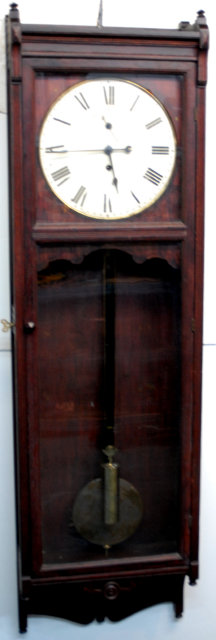
62. $3850
Seth Thomas Clock Co. “Regulator No. 17”, ca 1884. The oak case
is 68 inches tall, stained very dark to more resemble mahogany and nothing has been cleaned. The door has three key locks on the side,
all operational. The dial I believe to have original paint, hands are correct, brass dial ring, brass beat scale, wood pendulum stick
painted black, large pendulum bob appears to have originally been a nickel color but someone painted gold over it to make it look
brass to match the other brass accessories. I would remove the rest of the paint then go from there. The 8-day timepiece movement
is their No. 62 movement, properly signed, has cut pinions, maintaining power, and beats seconds. The case is 68” high, beautifully
polished and well-maintained oak that is all original including the seven small finials and the bottom decorations, wood door knob,
the wood dial board, and the two glasses. There has been repairs made to the top and base but it looks to be identical to the
originals. The brass weight, brass beat scale, and brass pulley all seem to be original to the clock. The case and movement are pictured
in Ly-Seth Thomas, pages 298-299. In nice original condition we have seen this model sell for over $10,000. The only two we have ever
sold went for over $5000. $4000-$6000.


63. $3500
George A. Jones & Co. pinwheel Regulator No. 4, wall clock,
ca 1864-1873. Jones made clocks in Bristol, Conn. and New York, all of which are extremely rare and valuable today. This clock is
an original Jones pinwheel regulator and in a similar style to many other models he made over the years. The beautiful mahogany case
is 7 feet tall with a large finial on top and 3 finials on the bottom. It is practically impossible to carry and hang the clock with
the bottom finial intact. It is not broken but apparently everyone removes it before hanging the clock. The porcelain dial, hands,
8-day movement, brass weight, and large lyre pendulum are all original to the case. Jones workmanship on the movement and case are
extremely high grade and this clock is typical of Jones’ quality workmanship. The movement is running properly but I suggest inspecting
the weight cord and movement before long term use. George Jones clocks do not come up often and this is an excellent example of one.
$3500-$5000.
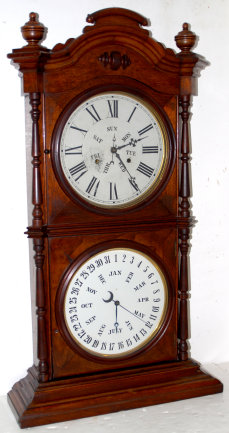
64. $3500
Welch, Spring & Company shelf calendar clock, “Auber, B.W.”,
ca 1870. This is a very imposing clock that stands 42” high and made of either walnut or mahogany. It has all the wood parts and they
appear to be original, but I would rarely guarantee finials to be original. The case is sound and has no problems other than a nick
or scratch that you must look hard to find. Upper round bezel has only a latch, the bottom door has a key lock with a key. Both dials
are original, the bottom nicer than the top, which is always the case for you cannot touch the bottom dial unless you take the door
apart. The top dial always has rub marks and will get dirty because it is exposed. We believe the five hands to be original, same
with the pendulum, the pair of heavy iron weights, and the signed Welch key. The only label is the complete black label over the lower
V calendar movement. The label is signed by both B. B. Lewis and Welch, Spring & Co. The lower half of the backboard has a black
paper covering. Welch, Spring used a strap brass movement from the S. C. Spring Clock Company stock, which was formerly the Birge,
Peck & Company. The movement runs 8-days and strikes on a coil gong. This is a very rare clock. We searched several years auction
records, mostly the large east coast auction houses and could not find one sale of this model. The previous owner bought it over 10
years ago for $7,000. Ly-Calendar, page 338. Also in Ly-Welch, and “Millers Calendar Clocks”, page 69. $3500-$5000.